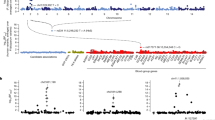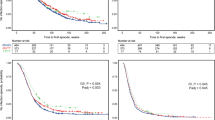Abstract
The chromosome 21q22.11 cytokine receptor cluster contains four genes that encode subunits of the receptors for the cytokines interleukin-10 and interferon-alpha, -beta and -gamma that may have a role in malaria pathogenesis. A total of 15 polymorphic markers located within these genes were initially genotyped in 190 controls and 190 severe malaria cases from The Gambia. Two interferon-alpha receptor-1 (IFNAR1) gene SNPs (17470 and L168 V) showed evidence for an association with severe malaria phenotypes and were typed in a larger series of samples comprising 538 severe malaria cases, 338 mild malaria cases and 562 controls. Both the 17470-G/G and L168V-G/G genotypes were associated with protection against severe malaria, in general, and cerebral malaria, in particular (P=0.004 and 0.003, respectively). IFNAR1 diplotypes were then constructed for these two markers using the PHASE software package. The (17470-G L168V-G/17470-G L168V-G) diplotype was found to be associated with a reduced risk of cerebral malaria and the (17470-C L168V-C/17470-G L168V-G) diplotype with an increased risk of cerebral malaria (overall 3 × 2 χ2=12.8, d.f.=2, P=0.002 and 3 × 2 χ2=15.2, d.f.=2, P=0.0005, respectively). These data suggest a role for the type I interferon pathway in resistance to cerebral malaria.
This is a preview of subscription content, access via your institution
Access options
Subscribe to this journal
Receive 6 digital issues and online access to articles
$119.00 per year
only $19.83 per issue
Buy this article
- Purchase on Springer Link
- Instant access to full article PDF
Prices may be subject to local taxes which are calculated during checkout

Similar content being viewed by others
References
Butler D, Maurice J, O'Brien C . Time to put malaria control on the global agenda [news] [see comments]. Nature 1997; 386: 535–536.
Rihet P, Traoré Y, Abel L, Aucan C, Traoré-Leroux T, Fumoux F . Malaria in humans: Plasmodium falciparum blood infection levels are linked to chromosome 5q31–q33. Am J Hum Genet 1998; 63: 498–505.
Jepson A, Sisay JF, Banya W et al. Genetic linkage of mild malaria to the major histocompatibility complex in Gambian children: study of affected sibling pairs. BMJ 1997; 315: 96–97.
Hill AV . The genomics and genetics of human infectious disease susceptibility. Annu Rev Genomics Hum Genet 2001; 2: 373–400.
Kwiatkowski D, Hill AV, Sambou I et al. TNF concentration in fatal cerebral, non-fatal cerebral, and uncomplicated Plasmodium falciparum malaria. Lancet 1990; 336: 1201–1204.
Grau GE, Taylor TE, Molyneux ME et al. Tumor necrosis factor and disease severity in children with falciparum malaria. N Engl J Med 1989; 320: 1586–1591.
Lucas R, Lou J, Morel DR, Ricou B, Suter PM, Grau GE . TNF receptors in the microvascular pathology of acute respiratory distress syndrome and cerebral malaria. J Leukoc Biol 1997; 61: 551–558.
Koch O, Awomoyi A, Usen S et al. IFNGR1 gene promoter polymorphisms and susceptibility to cerebral malaria. J Infect Dis 2002; 185: 1684–1687.
Langer JA, Rashidbaigi A, Lai LW, Patterson D, Jones C . Sublocalization on chromosome 21 of human interferon-alpha receptor gene and the gene for an interferon-gamma response protein. Somat Cell Mol Genet 1990; 16: 231–240.
Lutfalla G, Holland SJ, Cinato E et al. Mutant U5A cells are complemented by an interferon-alpha beta receptor subunit generated by alternative processing of a new member of a cytokine receptor gene cluster. EMBO J 1995; 14: 5100–5108.
Reboul J, Gardiner K, Monneron D, Uze G, Lutfalla G . Comparative genomic analysis of the interferon/interleukin-10 receptor gene cluster. Genome Res 1999; 9: 242–250.
Luty AJ, Lell B, Schmidt OR et al. Interferon-gamma responses are associated with resistance to reinfection with Plasmodium falciparum in young African children. J Infect Dis 1999; 179: 980–988.
Ferreira A, Schofield L, Enea V et al. Inhibition of development of exoerythrocytic forms of malaria parasites by gamma-interferon. Science 1986; 232: 881–884.
Herrera MA, Rosero F, Herrera S et al. Protection against malaria in Aotus monkeys immunized with a recombinant blood-stage antigen fused to a universal T-cell epitope: correlation of serum gamma interferon levels with protection. Infect Immun 1992; 60: 154–158.
Kurtis JD, Lanar DE, Opollo M, Duffy PE . Interleukin-10 responses to liver-stage antigen 1 predict human resistance to Plasmodium falciparum. Infect Immun 1999; 67: 3424–3429.
Othoro C, Lal AA, Nahlen B, Koech D, Orago AS, Udhayakumar V . A low interleukin-10 tumor necrosis factor-alpha ratio is associated with malaria anemia in children residing in a holoendemic malaria region in western Kenya [see comments]. J Infect Dis 1999; 179: 279–282.
May J, Lell B, Luty AJ, Meyer CG, Kremsner PG . Plasma interleukin-10:tumor necrosis factor (TNF)-alpha ratio is associated with TNF promoter variants and predicts malarial complications. J Infect Dis 2000; 182: 1570–1573.
Riley EM, Olerup O, Troye-Blomberg M . The immune recognition of Malaria antigens. Parasitol Today 1991; 7: 5–11.
Bogdan C . The function of type I interferons in antimicrobial immunity. Curr Opin Immunol 2000; 12: 419–424.
Vigario AM, Belnoue E, Cumano A et al. Inhibition of Plasmodium yoelii blood-stage malaria by interferon alpha through the inhibition of the production of its target cell, the reticulocyte. Blood 2001; 97: 3966–3971.
Sturchler D, Berger R, Etlinger H et al. Effects of interferons on immune response to a synthetic peptide malaria sporozoite vaccine in non-immune adults. Vaccine 1989; 7: 457–461.
Luty AJ, Perkins DJ, Lell B et al. Low interleukin-12 activity in severe Plasmodium falciparum malaria. Infect Immun 2000; 68: 3909–3915.
Malaguarnera L, Musumeci S . The immune response to Plasmodium falciparum malaria. Lancet Infect Dis 2002; 2: 472–478.
Modiano D, Petrarca V, Sirima BS et al. Different response to Plasmodium falciparum malaria in west African sympatric ethnic groups. Proc Natl Acad Sci USA 1996; 93: 13206–13211.
Hill AV, Allsopp CE, Kwiatkowski D et al. Common west African HLA antigens are associated with protection from severe malaria. Nature 1991; 352: 595–600.
Aucan C, Walley AJ, Greenwood BM, Hill AV . Haptoglobin genotypes are not associated with resistance to severe malaria in The Gambia. Trans Roy Soc Trop Med Hyg 2002; 96: 327–328.
Aitman TJ, Cooper LD, Norsworthy PJ et al. Malaria susceptibility and CD36 mutation. Nature 2000; 405: 1015–1016.
Modiano D, Luoni G, Sirima BS et al. Haemoglobin C protects against clinical Plasmodium falciparum malaria. Nature 2001; 414: 305–308.
Yan H, Krishnan K, Greenlund AC et al. Phosphorylated interferon-alpha receptor 1 subunit (IFNaR1) acts as a docking site for the latent form of the 113 kDa STAT2 protein. EMBO J 1996; 15: 1064–1074.
Colamonici O, Yan H, Domanski P et al. Direct binding to and tyrosine phosphorylation of the alpha subunit of the type I interferon receptor by p135tyk2 tyrosine kinase. Mol Cell Biol 1994; 14: 8133–8142.
Day DJ, Speiser PW, Schulze E et al. Identification of non-amplifying CYP21 genes when using PCR-based diagnosis of 21-hydroxylase deficiency in congenital adrenal hyperplasia (CAH) affected pedigrees. Hum Mol Genet 1996; 5: 2039–2048.
Hosmer DW, Lemeshow S . Applied Logistic Regression. Wiley, New York, 1989.
Stephens M, Smith NJ, Donnelly P . A new statistical method for haplotype reconstruction from population data. Am J Hum Genet 2001; 68: 978–989.
Abecasis GR, Cookson WO . GOLD—graphical overview of linkage disequilibrium. Bioinformatics 2000; 16: 182–183.
Acknowledgements
This work was funded by the Wellcome Trust. AVSH is a Wellcome Trust Principal Research Fellow. The authors thank the many investigators involved in the original case–control study in The Gambia for their contributions.
Author information
Authors and Affiliations
Corresponding author
Rights and permissions
About this article
Cite this article
Aucan, C., Walley, A., Hennig, B. et al. Interferon-alpha receptor-1 (IFNAR1) variants are associated with protection against cerebral malaria in The Gambia. Genes Immun 4, 275–282 (2003). https://doi.org/10.1038/sj.gene.6363962
Published:
Issue Date:
DOI: https://doi.org/10.1038/sj.gene.6363962
Keywords
This article is cited by
-
Genetic variation in the immune system and malaria susceptibility in infants: a nested case–control study in Nanoro, Burkina Faso
Malaria Journal (2021)
-
A proline deletion in IFNAR1 impairs IFN-signaling and underlies increased resistance to tuberculosis in humans
Nature Communications (2018)
-
Innate sensing of malaria parasites
Nature Reviews Immunology (2014)
-
Interferon signatures in immune disorders and disease
Immunology & Cell Biology (2012)
-
Uncovering the role of IFNAR1 in experimental cerebral malaria
Malaria Journal (2010)



